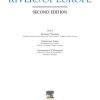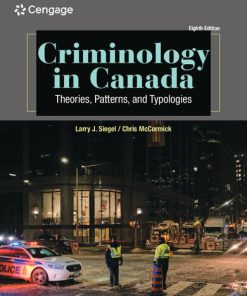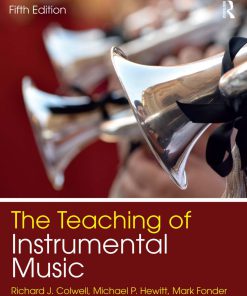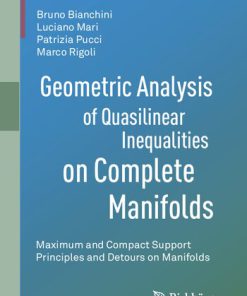Undergraduate Instrumental Analysis 8th Edition by Thomas Bruno, James Robinson, Eileen Skelly Frame, George Frame 1032036915 9781032036915
$50.00 Original price was: $50.00.$25.00Current price is: $25.00.
Undergraduate Instrumental Analysis 8th Edition by Thomas Bruno, James Robinson, Eileen Skelly Frame, George Frame – Ebook PDF Instant Download/Delivery: 1032036915, 9781032036915
Full download Undergraduate Instrumental Analysis 8th Edition after payment
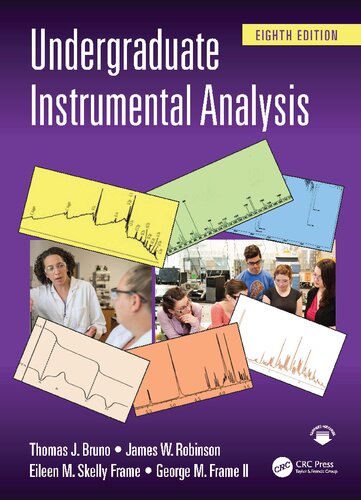
Product details:
ISBN 10: 1032036915
ISBN 13: 9781032036915
Author: Thomas J. Bruno, James W. Robinson, Eileen M. Skelly Frame, George M. Frame
Analytical instrumentation is crucial to research in molecular biology, medicine, geology, food science, materials science, forensics, and many other fields. Undergraduate Instrumental Analysis, 8th Edition, provides the reader with an understanding of all major instrumental analyses, and is unique in that it starts with the fundamental principles, and then develops the level of sophistication that is needed to make each method a workable tool for the student. Each chapter includes a discussion of the fundamental principles underlying each technique, detailed descriptions of the instrumentation, and a large number of applications. Each chapter includes an updated bibliography and problems, and most chapters have suggested experiments appropriate to the technique. This edition has been completely updated, revised, and expanded. The order of presentation has been changed from the 7th edition in that after the introduction to spectroscopy, UV-Vis is discussed. This order is more in keeping with the preference of most instructors. Naturally, once the fundamentals are introduced, instructors are free to change the order of presentation. Mathematics beyond algebra is kept to a minimum, but for the interested student, in this edition we provide an expanded discussion of measurement uncertainty that uses elementary calculus (although a formula approach can be used with no loss of context). Unique among all instrumental analysis texts we explicitly discuss safety, up front in Chapter 2. The presentation intentionally avoids a finger-wagging, thou-shalt-not approach in favor of a how-to discussion of good laboratory and industrial practice. It is focused on hazards (and remedies) that might be encountered in the use of instrumentation. Among the new topics introduced in this edition are: • Photoacoustic spectroscopy. • Cryogenic NMR probes and actively shielded magnets. • The nature of mixtures (in the context of separations). • Troubleshooting and leaks in high vacuum systems such as mass spectrometers. • Instrumentation laboratory safety. • Standard reference materials and standard reference data. In addition, the authors have included many instrument manufacturer’s websites, which contain extensive resources. We have also included many government websites and a discussion of resources available from National Measurement Laboratories in all industrialized countries. Students are introduced to standard methods and protocols developed by regulatory agencies and consensus standards organizations in this context as well.
Undergraduate Instrumental Analysis 8th Table of contents:
Chapter 1 Concepts of Instrumental Analytical Chemistry
1.1 Introduction: What Is Analytical Chemistry?
1.1.1 The Difference between Weight and Mass
1.2 Analytical Approach
1.2.1 Defining the Problem
1.2.2 Designing the Analytical Method
1.2.3 Sampling
1.2.4 Storage of Samples
1.3 A Conceptual Discussion About Uncertainty in Measurements
1.4 BASIC Statistics and Data Handling
1.4.1 Significant Figures
1.4.2 Accuracy and Precision
1.4.3 Types of Errors
1.4.4 Definitions for Statistics
1.4.5 Quantifying Random Error
1.4.6 Detection of Outliers
1.4.7 Expressing Uncertainty
1.5 Sample Preparation
1.5.1 Acid Dissolution and Digestion
1.5.2 Fusions
1.5.3 Dry Ashing and Combustion
1.5.4 Extraction
1.6 Performing the Measurement
1.6.1 Signals and Noise
1.6.2 Plotting Calibration Curves
1.7 Assessing The Data
1.7.1 Limit of Detection
1.7.2 Limit of Quantitation
1.8 Reference Materials and Reference Data
1.8.1 Reference Materials
1.8.2 Reference Data
Problems
Bibliography
Chapter 2 Safety in the Instrumentation Laboratory
2.1 Electrical Hazards and Safety
2.1.1 Electrical Lines, Receptacles, and Cables
2.1.2 PAT Testing Procedures in the U.K.
2.1.3 Electrical Shocks
2.1.4 Batteries
2.1.5 Portable Generators
2.1.6 A Brief Discussion about Ground
2.2 Instrument Cooling
2.3 Compressed Gas Cylinder Safety
2.3.1 Compressed Gas Regulators and Manifolds
2.3.2 Gas Cylinder Markings
2.4 Cryogenic Fluid Safety
2.4.1 Cryogenic Fluids
2.4.2 Cryogenic Liquid Containers
2.5 The Use of Fume Hoods in the Instrumentation Laboratory
2.6 Laser Safety
2.7 Compressed Air Line Safety
2.8 Ladder Safety
2.8.1 Step Ladders
2.8.2 Straight, Combination, and Extension Ladders
2.9 Hearing Protection
2.10 Selection of Laboratory Gloves
2.11 Selection of Respirator Cartridges and Filters
2.12 Safety with Nanomaterials
2.13 Relative Dose Ranges from Ionizing Radiation
2.14 Magnetic Field Safety
2.15 Miscellaneous Hazardous Conditions and Fire Safety
2.15.1 Fire Extinguishers
2.15.2 Hot Work Permits
2.16 Stop Work Orders
References
Chapter 3 Introduction to Spectroscopy
3.1 Interaction Between Electromagnetic Radiation and Matter
3.1.1 What Is Electromagnetic Radiation?
3.1.2 How Does Electromagnetic Radiation Interact with Matter?
3.2 Atoms and Atomic Spectroscopy
3.3 Molecules and Molecular Spectroscopy
3.3.1 Rotational Transitions in Molecules
3.3.2 Vibrational Transitions in Molecules
3.3.3 Electronic Transitions in Molecules
3.4 Absorption Laws
3.4.1 Deviations from Beer’s Law
3.5 Methods of Calibration
3.5.1 Calibration with Standards
3.5.2 Method of Standard Additions
3.5.3 Internal Standard Calibration
3.5.4 Errors Associated with Beer’s Law Relationships
3.6 Optical Systems used in Spectroscopy
3.6.1 Radiation Sources
3.6.2 Wavelength Selection Devices
3.6.3 Optical Slits
3.6.4 Detectors
3.6.5 Single-Beam and Double-Beam Optics
3.6.6 Dispersive Optical Layouts
3.6.7 Fourier Transform Spectrometers
3.7 Spectroscopic Technique and Instrument Nomenclature
Suggested Experiments
Problems
Bibliography
Chapter 4 Visible and Ultraviolet Molecular Spectroscopy
4.1 Introduction
4.1.1 Electronic Excitation in Molecules
4.1.2 Absorption by Molecules
4.1.3 Molar Absorptivity
4.1.4 Shape of UV Absorption Curves
4.1.5 Solvents for UV/VIS Spectroscopy
4.2 Instrumentation
4.2.1 Optical System
4.2.2 Radiation Sources
4.2.3 Monochromators
4.2.4 Detectors
4.2.5 Sample Holders
4.2.6 Microvolume, Nanovolume, and Handheld UV/VIS Spectrometers
4.3 UV Absorption Spectra of Molecules
4.3.1 Solvent Effects on UV Spectra
4.4 UV Spectra and The Structure of Organic Molecules
4.4.1 Conjugated Diene Systems
4.4.2 Conjugated Ketone Systems
4.4.3 Substitution of Benzene Rings
4.5 Analytical Applications
4.5.1 Qualitative Structural Analysis
4.5.2 Quantitative Analysis
4.5.3 Multicomponent Determinations
4.5.4 Other Applications
4.5.5 Measurement of Color
4.6 Accuracy and Precision in UV/VIS Absorption Spectrometry
4.7 Nephelometry and Turbidimetry
4.8 Molecular Emission Spectrometry
4.8.1 Fluorescence and Phosphorescence
4.8.2 Relationship between Fluorescence Intensity and Concentration
4.9 Instrumentation for Luminescence Measurements
4.9.1 Wavelength Selection Devices
4.9.2 Radiation Sources
4.9.3 Detectors
4.9.4 Sample Cells
4.9.5 Spectrometer Systems
4.10 Analytical Applications of Luminescence
4.10.1 Advantages of Fluorescence and Phosphorescence
4.10.2 Disadvantages of Fluorescence and Phosphorescence
Suggested Experiments
Problems
BIbliography
Chapter 5 Infrared, Near-Infrared, Raman, and Photoacoustic Spectroscopy
5.1 Absorption of IR Radiation by Molecules
5.1.1 Dipole Moments in Molecules
5.1.2 Types of Vibrations in Molecules
5.1.3 Vibrational Motion
5.2 IR Instrumentation
5.2.1 Radiation Sources
5.2.2 Monochromators and Interferometers
5.2.3 Detectors
5.2.4 Detector Response Time
5.3 Sampling Techniques
5.3.1 Techniques for Transmission (Absorption) Measurements
5.3.2 Background Correction in Transmission Measurements
5.3.3 Techniques for Reflectance and Emission Measurements
5.4 Ftir Microscopy
5.5 Nondispersive Ir SYSTEMS
5.6 Analytical Applications of IR Spectroscopy
5.6.1 Qualitative Analyses and Structural Determination by Mid-IR Absorption Spectroscopy
5.6.2 Quantitative Analyses by IR Spectrometry
5.7 NIR Spectroscopy
5.7.1 Instrumentation
5.7.2 NIR Vibrational Bands, Spectral Interpretation, and Calibration
5.7.3 Sampling Techniques for NIR Spectroscopy
5.7.4 Applications of NIR Spectroscopy
5.8 Raman Spectroscopy
5.8.1 Principles of Raman Scattering
5.8.2 Raman Instrumentation
5.8.3 Applications of Raman Spectroscopy
5.8.4 Resonance Raman Effect
5.8.5 Surface-Enhanced Raman Spectroscopy
5.8.6 Raman Microscopy
5.9 Chemical Imaging using NIR, IR, and Raman Spectroscopy
5.10 Photoacoustic Spectoscopy
Suggested Experiments
Problems
Bibliography
Chapter 6 Magnetic Resonance Spectroscopy
6.1 Introduction to Nuclear Magnetic Resonance Spectroscopy
6.1.1 Properties of Nuclei
6.1.2 Quantization of 1H Nuclei in a Magnetic Field
6.1.3 Width of Absorption Lines
6.2 FT-NMR Experiment
6.3 Chemical Shifts
6.4 Spin–Spin Coupling
6.5 Instrumentation
6.5.1 Sample Holder
6.5.2 Sample Probe
6.5.3 Magnet
6.5.4 RF Generation and Detection
6.5.5 Signal Integrator and Computer
6.6 Analytical Applications of NMR
6.6.1 Samples and Sample Preparation for NMR
6.6.2 Qualitative Analyses: Molecular Structure Determination
6.6.3 Interpretation of Proton Spectra
6.6.4 13C NMR
6.6.5 2D NMR
6.6.6 Qualitative Analyses: Other Applications
6.6.7 Quantitative Analyses
6.7 Hyphenated NMR Techniques
6.8 NMR Imaging and MRI
6.9 TIME Domain NMR
6.9.1 Solid Fat Content Determination by TD-NMR
6.9.2 Field Homogeneity and Spin Echo
6.9.3 Relaxation Time Distribution
6.9.4 TD-NMR Applications
6.10 Low-Field, Portable, and Miniature NMR Instruments
6.11 Limitations of NMR
6.12 Electron Spin Resonance Spectroscopy
6.12.1 Instrumentation
6.12.2 Miniature ESR Spectroscopy
6.12.3 ESR Spectra and Hyperfine Interactions
6.12.4 Applications
6.12.5 CW-Endor
Suggested Experiments
Problems
Bibliography
Chapter 7 Atomic Absorption Spectrometry
7.1 Absorption of Radiant Energy by Atoms
7.1.1 Spectral Linewidth
7.1.2 Degree of Radiant Energy Absorption
7.2 Instrumentation
7.2.1 Radiation Sources
7.2.2 Atomizers
7.2.3 Spectrometer Optics
7.2.4 Detectors
7.2.5 Modulation
7.2.6 Commercial AAS Systems
7.3 Atomization Process
7.3.1 Flame Atomization
7.3.2 Graphite Furnace Atomization
7.4 Interferences in AAS
7.4.1 Nonspectral Interferences
7.4.2 Spectral Interferences
7.5 Analytical Applications of AAS
7.5.1 Qualitative Analysis
7.5.2 Quantitative Analysis
7.5.3 Analysis of Samples
Suggested Experiments
Problems
7.A Appendix
7.B Appendix
Bibliography
Chapter 8 Atomic Emission Spectroscopy
8.1 Flame Atomic Emission Spectroscopy
8.1.1 Instrumentation for Flame OES
8.1.2 Interferences
8.1.3 Analytical Applications of Flame OES
8.2 Atomic OES
8.2.1 Instrumentation for Emission Spectroscopy
8.2.2 Interferences in Arc and Spark Emission Spectroscopy
8.2.3 Applications of Arc and Spark Emission Spectroscopy
8.3 Plasma Emission Spectroscopy
8.3.1 Instrumentation for Plasma Emission Spectrometry
8.3.2 Interferences and Calibration in Plasma Emission Spectrometry
8.3.3 Applications of ICP, DCP, and MP Atomic Emission Spectroscopy
8.3.4 Chemical Speciation with Hyphenated Instruments
8.4 GD Emission Spectrometry
8.4.1 DC and RF GD Sources
8.4.2 Applications of GD Atomic Emission Spectrometry
8.5 Atomic Fluorescence Spectroscopy
8.5.1 Instrumentation for AFS
8.5.2 Interferences in AFS
8.5.3 Applications of AFS
8.6 Commercial Atomic Emission SYSTEMS
8.6.1 Arc and Spark Systems
8.6.2 ICP, DCP, and MP Systems
8.6.3 GD Systems
8.6.4 AFS Systems
8.7 Laser-Induced Breakdown Spectroscopy
8.7.1 Principle of Operation
8.7.2 Instrumentation
8.7.3 Applications of LIBS
8.7.4 Commercial LIBS Systems
8.8 Atomic Emission Literature and Resources
8.9 Comparison of Atomic Spectroscopic and ICP-MS Techniques
Suggested Experiments
Flame Emission
Arc/Spark or ICP Emission
ICP Emission
PROBLEMS
8.A Appendix
8.B Appendix: Comparison of Atomic Spectroscopic Analytical Techniques
8.B.1 Flame Atomic Absorption
8.B.2 GFAAS
8.B.3 ICP-OES
8.B.4 ICP-MS
8.B.5 LIBS
Bibliography
Chapter 9 X-Ray Spectroscopy1
9.1 Origin of X-Ray Spectra
9.1.1 Energy Levels in Atoms
9.1.2 Moseley’s Law
9.1.3 X-Ray Methods
9.2 X-Ray Fluorescence
9.2.1 X-Ray Source
9.2.2 Instrumentation for Energy-Dispersive X-Ray Spectrometry
9.2.3 Instrumentation for Wavelength-Dispersive X-Ray Spectrometry
9.2.4 Simultaneous WDXRF Spectrometers
9.2.5 Micro-XRF Instrumentation
9.2.6 Total Reflection XRF
9.2.7 Comparison between EDXRF and WDXRF
9.2.8 XRF Applications
9.3 X-RAY Absorption
9.3.1 EXAFS
9.4 X-Ray Diffraction
9.4.1 Single-Crystal X-Ray Diffractometry
9.4.2 Crystal Growing
9.4.3 Crystal Structure Determination
9.4.4 Powder X-Ray Diffractometry
9.4.5 Hybrid XRD/XRF Systems
9.4.6 Applications of XRD
9.5 X-Ray Emission
9.5.1 Electron Probe Microanalysis
9.5.2 Particle-Induced X-Ray Emission
9.6 Commercial X-Ray Instrument Manufacturers
Suggested Experiments/Tutorials
X-Ray Absorption
X-Ray Fluorescence
X-Ray Diffraction
Problems
9.A Appendix: Characteristic x-ray Wavelengths (Å) and Energies (KEV)*
9.B Appendix: Absorption Edge Wavelengths and Energies
Notes
BIBLIOGRAPHY
Chapter 10 Mass Spectrometry I: Principles and Instrumentation
10.1 Principles of MS
10.1.1 Resolving Power and Resolution of a Mass Spectrometer
10.2 Instrumentation
10.2.1 Sample Input Systems
10.2.2 Ionization Sources
10.2.3 Mass Analyzers
10.2.4 Detectors
10.3 Ion Mobility SPECTROMETRY
10.3.1 Handheld DMS JUNO® Chemical Trace Vapor Point Detector
10.3.2 Excellims HPIMS-LC System
10.3.3 Photonis Ion Mobility Spectrometer Engine
10.3.4 SYNAPT G2-S Multistage MS System Incorporating the TriWAVE Ion Mobility Stage
10.4 Leaks in Mass Spectrometer Systems
Problems
Bibliography
Chapter 11 Mass Spectrometry II Spectral Interpretation and Applications
11.1 Interpretation of Mass Spectra: Structural Determination of Simple Molecules
11.1.1 Molecular Ion and Fragmentation Patterns
11.1.2 Nitrogen Rule
11.1.3 Molecular Formulas and Isotopic Abundances
11.1.4 Compounds with Heteroatoms
11.1.5 Halogen Isotopic Clusters
11.1.6 Rings Plus Double Bonds
11.1.7 Common Mass Losses on Fragmentation
11.2 MASS SPECTRAL INTERPRETATION: SOME EXAMPLES
11.2.1 Mass Spectra of Hydrocarbons
11.2.2 Mass Spectra of Other Organic Compound Classes
11.2.3 Compounds Containing Heteroatoms
11.3 APPLICATIONS OF MOLECULAR MS
11.3.1 High-Resolution Mass Spectrometry
11.3.2 Quantitative Analysis of Compounds and Mixtures
11.3.3 Protein-Sequencing Analysis (Proteomics)
11.3.4 Gas Analysis
11.3.5 Environmental Applications
11.3.6 Other Applications of Molecular MS
11.3.7 Limitations of Molecular MS
11.4 ATOMIC MS
11.4.1 ICP-MS
11.4.2 Applications of Atomic MS
11.4.3 Interferences in Atomic MS
11.4.4 Instrumental Approaches to Eliminating Interferences
11.4.5 Limitations of Atomic MS
11.5 Common Spurious Effects in Mass Spectrometry
Problems
11.A Appendix
BIBLIOGRAPHY
Chapter 12 Principles of Chromatography
12.1 Introduction to Chromatography
12.2 The Nature of Mixtures
12.3 What Is the Chromatographic Process?
12.4 Chromatography in More Than one Dimension
12.5 Visualization of The Chromatographic Process At The Molecular Level: Analogy To “People on A Moving Belt Slideway”
12.6 DIGRESSION ON THE CENTRAL ROLE OF SILICON–OXYGEN COMPOUNDS IN CHROMATOGRAPHY
12.7 BASIC EQUATIONS DESCRIBING CHROMATOGRAPHIC SEPARATIONS
12.8 HOW DO COLUMN VARIABLES AFFECT EFFICIENCY (PLATE HEIGHT)?
12.9 PRACTICAL OPTIMIZATION OF CHROMATOGRAPHIC SEPARATIONS
12.10 EXTRA-COLUMN BAND BROADENING EFFECTS
12.11 QUALITATIVE CHROMATOGRAPHY: ANALYTE IDENTIFICATION
12.12 QUANTITATIVE MEASUREMENTS IN CHROMATOGRAPHY
12.12.1 Peak Area or Peak Height: What Is Best for Quantitation?
12.12.2 Calibration with an External Standard
12.12.3 Calibration with an Internal Standard
12.13 EXAMPLES OF CHROMATOGRAPHIC CALCULATIONS
PROBLEMS
BIBLIOGRAPHY
Chapter 13 Gas Chromatography
13.1 HISTORICAL DEVELOPMENT OF GC: THE FIRST CHROMATOGRAPHIC INSTRUMENTATION
13.2 ADVANCES IN GC LEADING TO PRESENT-DAY INSTRUMENTATION
13.3 GC INSTRUMENT COMPONENT DESIGN (INJECTORS)
13.3.1 Syringes
13.3.2 Autosamplers
13.3.3 SPME
13.3.4 Split Injections
13.3.5 Splitless Injections
13.4 GC INSTRUMENT COMPONENT DESIGN (THE COLUMN)
13.4.1 Column Stationary Phase
13.4.2 Selecting a Stationary Phase for an Application
13.4.3 Effects of Mobile Phase Choice and Flow Parameters
13.5 GC INSTRUMENT OPERATION (COLUMN DIMENSIONS AND ELUTION VALUES)
13.6 GC INSTRUMENT OPERATION (COLUMN TEMPERATURE AND ELUTION VALUES)
13.7 GC INSTRUMENT COMPONENT DESIGN (DETECTORS)
13.7.1 Thermal Conductivity Detector
13.7.2 Flame Ionization Detector
13.7.3 Electron Capture Detector
13.7.4 Electrolytic Conductivity Detector
13.7.5 Sulfur–Phosphorus Flame Photometric Detector
13.7.6 Sulfur Chemiluminescence Detector
13.7.7 Nitrogen–Phosphorus Detector
13.7.8 Photoionization Detector
13.7.9 Helium Ionization Detector
13.7.10 Atomic Emission Detector
13.8 HYPHENATED GC TECHNIQUES (GC-MS, GC-IR, GC-GC, OR 2D GC)
13.8.1 GC-MS
13.8.2 GC-IR Spectrometry
13.8.3 Comprehensive 2D Gas Chromatography (GC × GC or GC2)
13.9 RETENTION INDICES (A GENERALIZATION OF RELATIVE Rt INFORMATION)
13.10 SCOPE OF GC ANALYSES
13.10.1 GC Behavior of Organic Compound Classes
13.10.2 Derivatization of Difficult Analytes to Improve GC Elution Behavior
13.10.3 Gas Analysis by GC
13.10.4 Limitations of GC
PROBLEMS
13.A APPENDIX: GC INTERNET WEB RESOURCES
Special GC Calculation Programs
Two Large Publisher Chromatography Websites
BIBLIOGRAPHY
Chapter 14 Chromatography with Liquid (and Fluid) Mobile Phases
14.1 HIGH-PERFORMANCE LIQUID CHROMATOGRAPHY
14.1.1 HPLC Column and Stationary Phases
14.1.2 Effects on Separation of Composition of the Mobile Phase
14.1.3 Design and Operation of an HPLC Instrument
14.1.4 HPLC Detector Design and Operation
14.1.5 Derivatization in HPLC
14.1.6 Hyphenated Techniques in HPLC
14.1.7 Applications of HPLC
14.2 CHROMATOGRAPHY OF IONS DISSOLVED IN LIQUIDS
14.2.1 Ion Chromatography
14.3 AFFINITY CHROMATOGRAPHY
14.4 SIZE-EXCLUSION CHROMATOGRAPHY
14.5 SUPERCRITICAL FLUID CHROMATOGRAPHY
14.5.1 Operating Conditions
14.5.2 Effect of Pressure
14.5.3 Stationary Phases
14.5.4 Mobile Phases
14.5.5 Detectors
14.5.6 SFC versus Other Column Methods
14.5.7 Applications
14.5.8 Ultra Performance Convergence Chromatography: A New Synthesis
14.6 ELECTROPHORESIS
14.6.1 Capillary Zone Electrophoresis (CZE)
14.6.2 Sample Injection in CZE
14.6.3 Detection in CZE
14.6.4 Modes of CE
14.6.5 Capillary Electrochromatography
14.7 PLANAR CHROMATOGRAPHY AND PLANAR ELECTROPHORESIS
14.7.1 Thin-Layer Chromatography
14.7.2 Planar Electrophoresis on Slab Gels
PROBLEMS AND EXERCISES
14.A APPENDIX LC/CE/TLC INTERNET WEB RESOURCES
Special LC Calculation Programs
Two Large Publisher Chromatography Websites
BIBLIOGRAPHY
Chapter 15 Electroanalytical Chemistry
15.1 FUNDAMENTALS OF ELECTROCHEMISTRY
15.2 ELECTROCHEMICAL CELLS
15.2.1 Line Notation for Cells and Half-Cells
15.2.2 Standard Reduction Potentials
15.2.3 Sign Conventions
15.2.4 Nernst Equation
15.2.5 Activity Series
15.2.6 Reference Electrodes
15.2.7 Electrical Double Layer
15.3 ELECTROANALYTICAL METHODS
15.3.1 Potentiometry
15.3.2 Coulometry
15.3.3 Conductometric Analysis
15.3.4 Polarography
15.3.5 Voltammetry
15.4 LIQUID CHROMATOGRAPHY DETECTORS
15.4.1 Voltammetric Detection
15.4.2 Conductometric Detection
15.5 SPECTROELECTROCHEMISTRY
15.6 QUARTZ CRYSTAL MICROBALANCE
15.6.1 Piezoelectric Effect
15.6.2 Electrochemical Quartz Crystal Microbalance
15.7 ELECTROCHEMISTRY AT THE NANOSCALE
SUGGESTED EXPERIMENTS
PROBLEMS
15.A APPENDIX: SELECTED STANDARD REDUCTION POTENTIALS AT 25 °C
BIBLIOGRAPHY
Chapter 16 Surface Analysis
16.1 INTRODUCTION
16.2 ELECTRON SPECTROSCOPY TECHNIQUES
16.2.1 X-Ray Photoelectron Spectroscopy
16.2.2 Auger Electron Spectroscopy
16.3 ION SCATTERING SPECTROSCOPY
16.4 SECONDARY ION MASS SPECTROMETRY
16.4.1 Instrumentation for SIMS
16.4.2 Analytical Applications of SIMS
16.5 ELECTRON MICROPROBE (ELECTRON PROBE MICROANALYSIS)
PROBLEMS
BIBLIOGRAPHY
Chapter 17 Thermal Analysis
17.1 THERMOGRAVIMETRY
17.1.1 TGA Instrumentation
17.1.2 Analytical Applications of Thermogravimetry
17.1.3 Derivative Thermogravimetry
17.1.4 Sources of Error in Thermogravimetry
17.2 DIFFERENTIAL THERMAL ANALYSIS
17.2.1 DTA Instrumentation
17.2.2 Analytical Applications of DTA
17.3 DIFFERENTIAL SCANNING CALORIMETRY
17.3.1 DSC Instrumentation
17.3.2 Applications of DSC
17.4 HYPHENATED TECHNIQUES
17.4.1 Hyphenated Thermal Methods
17.4.2 Evolved Gas Analysis
17.5 THERMOMETRIC TITRIMETRY
17.5.1 Applications of Thermometric Titrimetry
17.6 DIRECT INJECTION ENTHALPIMETRY
17.7 MICROCALORIMETRY
17.7.1 Micro-DSC Instrumentation
17.7.2 Applications of Micro-DSC
17.7.3 Isothermal Titration Calorimetry
17.7.4 Microliter Flow Calorimetry
17.8 THERMOMECHANICAL ANALYSIS AND DYNAMIC MECHANICAL ANALYSIS
17.8.1 Instrumentation
17.8.2 Applications of TMA and DMA
17.9 OPTICAL THERMAL ANALYSIS
17.9.1 Heating Microscope
17.9.2 Optical Dilatometers
17.9.3 Optical Thermal Analyzers with Differential Thermal Analysis
17.10 SUMMARY
People also search for Undergraduate Instrumental Analysis 8th:
2 instrumental
r and b instrumental study music
textbook instrumental
t instrumental
Tags:
Thomas Bruno,James Robinson,Eileen Skelly Frame,George FrameUndergraduate
You may also like…
Forensic Science
Criminology in Canada Theories, Patterns, and Typologies (Eighth Edition) Larry J. Siegel
Politics & Philosophy - Anthropology
The Teaching of Instrumental Music 5th Edition Richard J. Colwell
Fiction - Historical

